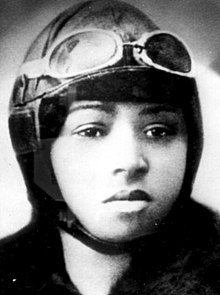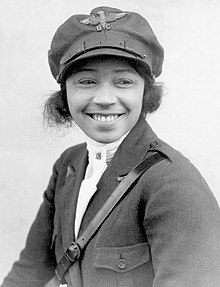Bessy Coleman
Bessie Coleman ( January 26, 1892 in Atlanta , Texas – April 30, 1926 in Jacksonville , Florida ), also "Brave Bessie" and "Queen Bess", was an American pilot. She was the first African American woman with a pilot's license and the first woman with an international pilot's license.
Life
childhood and adolescence
Bessie was the tenth of thirteen children born to her sharecropper parents. She also had Native American ( Choctaw ) ancestry from her father, George Coleman . She spent her early childhood on her parents' small farm, and Sundays were devoted to church attendance. While her older siblings gradually took over chores in the fields, it fell to Bessie to help her mother, Susan Coleman, around the house, with gardening, and supervising her younger siblings.
At the age of six she began to attend school; a one-room school for black children only. She was a very good student, even though her parents often couldn't buy her school supplies such as chalk or pencils. Her fondness was reading and she showed an exceptional talent for mathematics . The routine of school, housework, and Sunday church attendance was interrupted only by the annual cotton harvest , which all family members attended.
In 1901 her father left the family. He wanted to escape the racism in the southern states and returned to his native Oklahoma , which was still considered Indian Territory at the time and whose settlement by white people had only just begun, where he hoped for a better life. But the family did not follow him.
Bessie Coleman was accepted into the School of the Missionary Baptist Church at the age of twelve , continued her education and, after her 18th birthday, enrolled at Langston University with all her life savings. After only one semester, however, their funds were exhausted. She had to abandon her studies and returned home.
Chicago
In 1915 she followed two of her brothers to Chicago and lived with them. Together with them she first worked in a supermarket and was a manicurist in a hairdressing salon. There she heard the stories of pilots returning from the war and imagined what it would be like to be a pilot herself. Her brother teased her that French women were better than African Americans because French women had already become pilots.
She was determined to become a pilot, but because she was a woman and black, no flight school accepted her. On the other hand, she received support mainly from some influential members of the black community, whom she had met while working in the hair salon. Robert S. Abbott , founder and publisher of the Chicago Defender , the premier weekly newspaper for African Americans in Chicago, and Jesse Binga, a real estate salesman, sponsored her, and in return she used her engaging, vivacious personality and beauty to advertise for the Chicago Defender on. Abbott repeatedly addressed her career aspirations and the rejection she experienced in the process in his newspaper.
Pilot training in France
Coleman began attending French courses at the Berlitz language school and eventually traveled to France on November 20, 1920 to complete her pilot training there. As the only non-white student, she learned to fly there within a year.
return to the United States
When she returned to the United States in September 1921, she became a sought-after interviewee for newspapers and magazines, was invited to numerous events, and received recognition and admiration from both blacks and whites.
In the same year she took part in her first air show in Long Island . As a result, she was involved as a pilot in demonstrations across the United States, also surviving a number of accidents. In Los Angeles , on February 22, 1922, she broke her leg and three ribs when her plane failed and she crashed. As her fame grew, she was invited to take part in the film adaptation of her life. She agreed, but eventually stopped filming because she felt the script's depiction of black people was too cliched.
In 1922 she was the first woman to receive the international pilot's license from the Fédération Aéronautique Internationale . Their goal was to open the first flight school in the United States, in which it should also be possible for African Americans, who still had no access to the existing schools, to learn to fly.
Deadly accident
In the spring of 1926, Coleman had bought an airplane in Dallas and flown it to Jacksonville. Friends and family members advised her not to fly it, they did not think the plane was safe. On April 30, however, Coleman prepared for an air show with her mechanic and public relations agent, William Wills, who was at the controls.
During the flight, Coleman had not fastened her seat belt as she had planned a skydive for the next day and wanted to lean out of the cockpit to survey the terrain. After about twelve minutes, Wills was unable to level the plane from a dive. Instead, the plane went into a spin and crashed. At an altitude of about 600 meters, Coleman was thrown from the cockpit and died on impact with the ground. Wills died when the plane burst into flames after impact. Examination of the wreck determined that the accident was likely due to a wrench jammed in the steering mechanics.
Bessie Coleman is buried in Lincoln Cemetery in Chicago. Around 10,000 people attended her funeral, including many prominent members of the black community, such as civil rights activist Ida B. Wells .
honors
Bessie Coleman was the first African-American pilot to posthumously receive multiple awards. In 1931, a group of black pilots flew over her grave for the first time in her honor, a tradition that was later repeated annually. In 1995 her portrait appeared on a United States Postal Service stamp and in 1977 the Bessie Coleman Aviators Club of Black Pilots was formed. The international terminal of Chicago's O'Hare International Airport is on Bessie Coleman Drive .
Jazz saxophonist Johnny Hodges recorded Good Queen Bess , a piece he wrote, in 1940 .
In 2006 she was inducted into the National Aviation Hall of Fame .
A street is named after her in the Gateway Gardens conversion area near Frankfurt Airport .
A Google Doodle was dedicated to her on January 26, 2017, the 125th anniversary of her birth.
web links
| personal data | |
|---|---|
| SURNAME | Coleman, Bessie |
| ALTERNATIVE NAMES | Brave Bessie (nickname); Queen Bess (nickname) |
| BRIEF DESCRIPTION | American pilot |
| BIRTH DATE | January 26, 1892 |
| PLACE OF BIRTH | Atlanta , Texas |
| DATE OF DEATH | April 30, 1926 |
| PLACE OF DEATH | Jacksonville , Fla |


